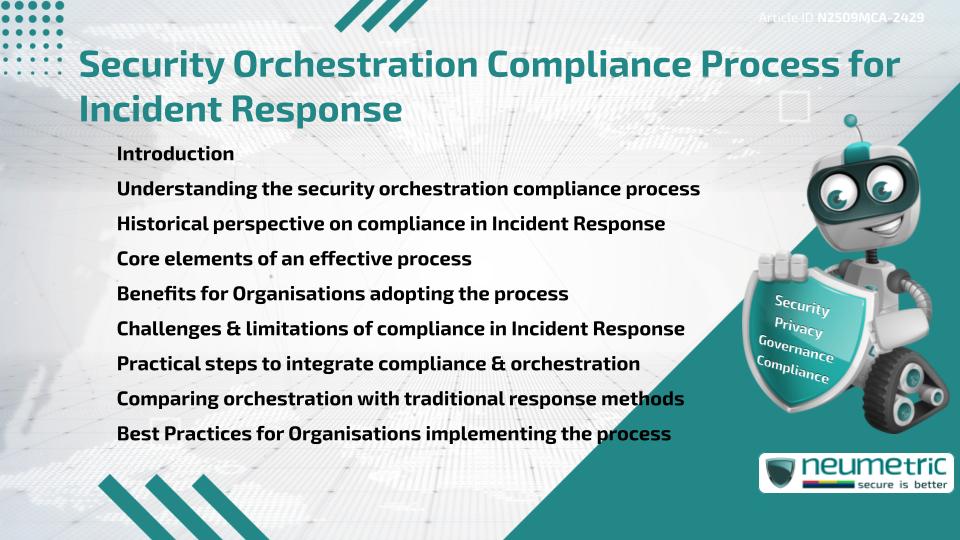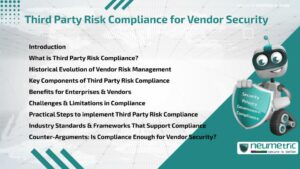Table of Contents
ToggleIntroduction
The security orchestration compliance process is a structured approach that combines automated response actions, policy enforcement & regulatory alignment to strengthen Incident Response. It enables Organisations to streamline Threat detection, reduce manual workloads & ensure that Security Measures align with industry requirements. By integrating orchestration with compliance, businesses can improve efficiency, reduce Risks & demonstrate accountability during audits. This article explores the key elements, history, benefits, challenges & practical steps to implement the security orchestration compliance process effectively.
Understanding the security orchestration compliance process
At its core, the security orchestration compliance process integrates automation with regulatory frameworks. Security orchestration involves linking multiple tools & workflows to respond quickly to incidents. Compliance ensures that these actions adhere to standards such as GDPR, HIPAA or ISO 27001. When combined, the process not only manages Threats but also documents every step for Audit readiness. This dual role helps Organisations maintain resilience while meeting legal obligations.
Historical perspective on compliance in Incident Response
Compliance in Cybersecurity has roots in early regulatory frameworks developed in the 1990s. Standards such as the Payment Card Industry Data Security Standard (PCI DSS) highlighted the need for strict incident handling. Initially, responses were manual & time-consuming, often creating gaps in reporting. The evolution of orchestration tools in the last two decades has changed this landscape. Today, compliance-driven orchestration ensures that Incident Response is not only faster but also transparent & consistent with external guidelines.
Core elements of an effective process
A successful security orchestration compliance process includes several critical components:
- Automation: Pre-defined playbooks trigger actions such as isolating devices or blocking malicious traffic.
- Documentation: Every action is logged for compliance purposes.
- Integration: Tools like SIEM & Threat Intelligence platforms work together.
- Policy mapping: Security steps are mapped to regulations for traceability.
- Continuous Monitoring: Threats are identified & addressed in real-time.
These elements ensure that Organisations stay compliant while responding efficiently.
Benefits for Organisations adopting the process
Organisations gain multiple advantages when they adopt a security orchestration compliance process. It reduces the time needed to detect & respond to Threats, lowering the Risk of breaches. It also minimizes manual errors by standardizing workflows. From a compliance perspective, businesses can provide Evidence of due diligence during audits, improving trust with regulators & Stakeholders. Moreover, automated documentation reduces administrative burdens & ensures consistency across teams.
Challenges & limitations of compliance in Incident Response
While valuable, this process is not without challenges. Integration across diverse tools can be complex, especially for Organisations with legacy systems. Automation may sometimes generate false positives, requiring human oversight. Additionally, Compliance Requirements vary across industries, which can make universal adoption difficult. There is also the cost factor, as implementing orchestration tools & training staff requires significant investment. Despite these limitations, the overall benefits often outweigh the drawbacks.
Practical steps to integrate compliance & orchestration
To integrate the security orchestration compliance process effectively, Organisations can follow practical steps:
- Assess regulatory requirements relevant to the industry.
- Develop orchestration playbooks aligned with these requirements.
- Integrate existing tools such as firewalls, SIEM & monitoring systems.
- Test workflows to minimise errors & false positives.
- Train staff to oversee automated processes & ensure alignment.
- Conduct regular Audits to confirm that compliance objectives are met.
These steps help Organisations balance automation with accountability.
Comparing orchestration with traditional response methods
Traditional Incident Response relied heavily on manual intervention, which often caused delays. In contrast, orchestration automates repetitive actions & ensures that responses are consistent with compliance standards. For example, instead of manually isolating a compromised endpoint, an orchestration system can do it instantly & record the action for auditors. This approach reduces response time & enhances transparency compared to manual methods.
Best Practices for Organisations implementing the process
Organisations seeking to implement a security orchestration compliance process should adopt Best Practices such as:
- Starting small with pilot programs before scaling.
- Keeping Compliance Requirements central to every workflow.
- Using metrics to measure improvements in detection & response.
- Ensuring collaboration between IT, security & compliance teams.
- Updating playbooks regularly as Threats & regulations evolve.
Following these practices ensures that both security & compliance objectives are achieved.
Conclusion
The security orchestration compliance process brings structure, automation & accountability to Incident Response. By combining orchestration with compliance, Organisations can protect assets, reduce Risks & maintain trust with regulators & Customers.
Takeaways
- The security orchestration compliance process merges automation with regulatory frameworks.
- It improves efficiency, accuracy & Audit readiness in Incident Response.
- Challenges include integration complexity, costs & false positives.
- Best Practices & structured steps can help Organisations adopt the process effectively.
FAQ
What is the main purpose of the security orchestration compliance process?
It ensures that Incident Response is fast, automated & aligned with Compliance Requirements.
How does it differ from traditional Incident Response methods?
Traditional methods are manual & slower, while orchestration automates actions & maintains compliance records.
Which regulations influence this process?
Regulations such as GDPR, HIPAA, PCI DSS & ISO 27001 shape Compliance Requirements.
What are the Risks of relying too much on automation?
Over-reliance can lead to false positives & overlooked Threats, so human oversight is still essential.
Can small Organisations adopt this process?
Yes, small Organisations can start with limited orchestration playbooks & gradually expand.
Why is documentation important in this process?
Documentation ensures accountability, provides Audit trails & demonstrates compliance during regulatory reviews.
How does this process improve trust with Stakeholders?
By showing that responses are consistent, transparent & aligned with regulations, Organisations build confidence among regulators & clients.
Need help for Security, Privacy, Governance & VAPT?
Neumetric provides organisations the necessary help to achieve their Cybersecurity, Compliance, Governance, Privacy, Certifications & Pentesting needs.
Organisations & Businesses, specifically those which provide SaaS & AI Solutions in the Fintech, BFSI & other regulated sectors, usually need a Cybersecurity Partner for meeting & maintaining the ongoing Security & Privacy needs & requirements of their Enterprise Clients & Privacy conscious Customers.
SOC 2, ISO 27001, ISO 42001, NIST, HIPAA, HECVAT, EU GDPR are some of the Frameworks that are served by Fusion – a SaaS, multimodular, multitenant, centralised, automated, Cybersecurity & Compliance Management system.
Neumetric also provides Expert Services for technical security which covers VAPT for Web Applications, APIs, iOS & Android Mobile Apps, Security Testing for AWS & other Cloud Environments & Cloud Infrastructure & other similar scopes.
Reach out to us by Email or filling out the Contact Form…





